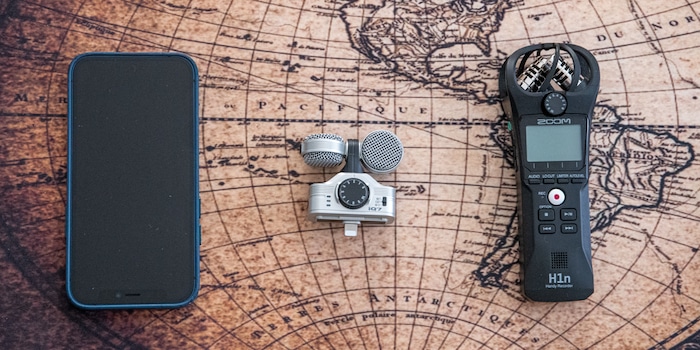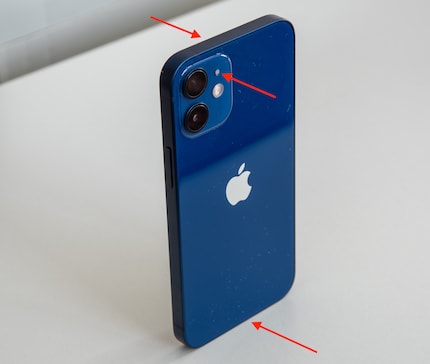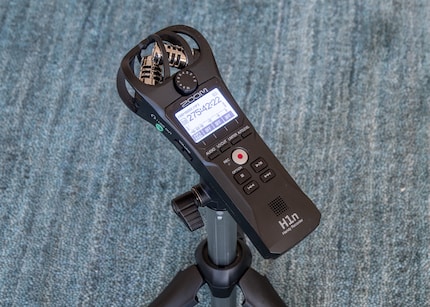

Recording live music in stereo: why I use a field recorder
I want a straightforward way of recording live music. Like most of you, I’ve just used my smartphone until now. But that has its pitfalls, primarily because I want the whole thing in stereo. I even surprised myself when I switched to an external audio recorder.
My smartphone makes it easy to capture concert clips, band rehearsals and my own song ideas. Phones like this have multiple microphones built in, meaning they’re also able to generate stereo sound. Sometimes, the result is pretty good, but other times, less so. Why is that? I got to the bottom of it and tested out several options.
Pure audio in mono; video in stereo
For context, I’m using an iPhone. The Voice Memos app comes preinstalled for sound recordings, while Garageband is available free for music. Both record in mono. No surprise given that does the job for voice notes. Garageband is designed to record multiple tracks one after the other and then combine them in a stereo mix. This is why I need to switch to video in the camera app for live recordings in stereo. Even then, the iPhone only records in stereo if the corresponding option is activated in the settings.
Which I find annoying. At a concert, video is great, but in our band rehearsals I don’t need visuals. This just makes the files bigger, and they end up impractical to send. Or I have to separate sound and image afterwards.
With special recording apps, you can also capture stereo without visuals. However, finding a good app has proven difficult – more on that later.
Setting up and using the built-in microphones
There are three microphones on my iPhone 12 mini. One on the bottom edge, and two more on top, with one on the front and the other on the back. The mics on other smartphones may be positioned slightly differently, but it shouldn’t be hard to find them.

Source: David Lee
To find out which microphone is being used right now, I rub my thumb and forefinger together right next to each one. You can only hear the sound well from very close. This makes it easy to distinguish a microphone in use from one that’s not.
The upshot of these tests is that the Voice Memo app, which only records sound, uses the mic on the bottom. Meanwhile, in video mode, the iPhone always uses the two microphones on the top, and the mic on the bottom remains inactive.
That really surprised me. For good surround sound, microphones need to be as far apart as possible. This was the case with my previous smartphone, the Huawei P20 Lite. With the help of a cardboard divider, it produced an almost binaural stereo sound.
Of course, that’s only an option when shooting in landscape format, but still. In portrait format, you can’t achieve a realistic stereo image given the microphone set-up – they’re all more or less on the centre line.
The layout and use of the built-in microphones accounts for why I was never satisfied with stereo sound. In particular, why the shots in landscape mode aren’t any better than portrait mode.
I now also realise why some band rehearsal recordings sound muffled. As I’m not interested in watching video, I place the iPhone on the table. As a result, the tabletop is covering one of the two active microphones. When recording from the front, this microphone records louder than the one on the screen side. With selfie shots, it’s the other way around.
Third-party apps
Maybe there’s an app that can record stereo sound with the microphones set apart. But I’ve not found one. Most dictation apps only record in mono. In Voice Record Pro, I can set it to stereo but it actually records in mono. In Recorder Plus, I can choose from numerous microphone sources; two of them use stereo. However, it does so in the same way as the camera app. In other words, not what I’m looking for. Quite a few recording apps rely on a subscription model with exorbitant prices. So much so I didn’t even look at them.
External microphone
Following these disappointing experiences, it becomes clear to me that I need an external microphone. There are countless options, but most record in mono. The Zoom iQ6 and iQ7 stereo microphones for iPhone are an exception. The iQ6 can only reasonably be used in portrait mode given its microphone layout. It’s a different story with the Zoom iQ7. Thanks to its rotating mechanism, the device delivers decent stereo sound in both portrait and landscape mode.

In theory, the Zoom iQ7 should actually be a high-quality, well-designed product. It boasts a knob, sound level display and headphone jack. A removable plastic cover lets the iPhone dock flush against the device, even if it’s still in a case. In the corresponding recording app on your iPhone, you can also rotate the screen 180 degrees. This normally doesn’t work, but you need to do it if you want to take a photo in portrait mode and attach the microphone on top.

Source: David Lee
In spite of these merits, I wouldn’t recommend the iQ7. The reason being it plugs directly into the iPhone’s data port, in other words, the lightning connector. This will soon be obsolete for iPhones, as the EU requires them to have a USB-C from the end of 2024. As a result, the microphone will only work on future iPhones with an adapter at best.
There’s a similar mic for Android with a USB-C, the Zoom AM7, but I haven’t tested it.
But that’s not where the downsides to my test microphone end. You can only share recordings in the app via iCloud, Soundcloud or e-mail. Other common methods including AirDrop are missing. What’s more, I always end up with noise interference. Switching to aeroplane mode reduces the annoying ticking sound, but you can still detect it. The firmware update doesn’t help. This is actually the biggest problem and makes the microphone unusable – but it could just be that I got a defective one.
Field recorder
The third option is to record sound with an external audio recorder. I used the Zoom H1n field recorder for this. It’s a simple, not too pricey device that’s adequate for what I need. You can see the audio level before recording and adjust it via a controller. As well as MP3, there are various uncompressed formats to choose from, which is important if you post-process the audio.
Video recording is more complex with an external recorder because you have to transfer both audio and visuals to the computer and synchronise them in an editing program. But it yields better results. And it works with any smartphone, as well as any camera.
All you need is a place to put the external recorder. Because holding both the recorder and smartphone at the same time is tricky. The recorder I use can be mounted onto an ordinary tabletop tripod.

Source: David Lee
In the following video, you can hear the difference between the internal microphone and the Zoom H1n. It doesn’t just provide improved surround sound but also better sound quality, such as clearer trebles. As I can hold the microphone directly in front of the source, the signal is stronger, meaning I can turn the gauge down. The result is less interference.
Consistent recordings instead of changes for the worse
The field recorder not only delivers improved stereo and sound quality, but also consistent recording. The video feature on my smartphone constantly tries to calculate something, thus making the end result worse. For instance, the recording often gets quieter when it should get louder and vice versa. That’s because the recording level adjusts automatically. To give you an example, here are two concert recordings from the same place: one with automatic sound settings and the other adjusted manually.
Another instance of optimisation we didn’t need or ask for is sound changes when you zoom into the image. As you’ll see in the example below, it’s very distracting. The iPhone tries to automatically match the sound to the image frame. But that doesn’t work here, as the sound of the electric instruments isn’t coming from the musicians, but rather from the speakers.
Incredibly versatile
Another advantage of the audio recorder is that I can easily record an entire concert. The two AAA batteries last ten hours according to Zoom, which should be about right. Alternatively, you can power the device ad infinitum via USB. Furthermore, there aren’t any limits to its storage space. The device uses microSD cards up to 32 GB that last a whopping 15 hours, even in the highest quality of 24 bit and 96 kHz. Uncompressed at 16 bit and 44.1 kHz (CD quality), it lasts for 50 hours. Meanwhile, at the highest MP3 quality, it can run for over 220 hours.
Verdict
So, should you carry a separate audio recorder along with your smartphone? I was incredibly sceptical at first, but now I’m won over. For my purposes, it’s just the thing. In future, I intend to record live music primarily with the field recorder. Only if I’m in a hurry and can’t transfer anything to my computer will I continue using a smartphone.
My interest in IT and writing landed me in tech journalism early on (2000). I want to know how we can use technology without being used. Outside of the office, I’m a keen musician who makes up for lacking talent with excessive enthusiasm.



